Since writing Part 1 back in June Chingford Historical Society have, with my help, hosted 6 online talks and are going from strength to strength with an influx of new members each month.
I have now amassed quite a few tips on hosting Zoom meetings and although I am by no means an expert I hope that my tips will help other historical societies make the move to online meetings.
This isn’t a beginner’s guide – there are plenty of those online but I hope these tips are of use to you. If you have any tips yourself please comment below.
In this post I frequently refer to the Settings menu. Once you are logged into your Zoom account you can click on this menu and then scroll down for the various options I refer to below.
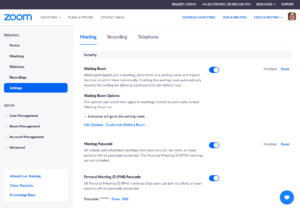
Technical test in advance of your meeting
The most important tip I would give in setting up a Zoom talk is to arrange a quick technical test with the speaker in advance of the meeting. This is very useful for checking things like the sound quality and whether the screen sharing works. Even if speakers have presented at many meetings it is still worth doing. I have hosted multiple meetings and various different issues do crop up and it is much more professional to sort them out in advance of the meeting rather than when the meeting is live and you have an audience watching your every move. Although there have been one or two blips with sound quality we have had many positive comments as to the smoothness of Chingford Historical Society’s online talks.
Set up a personalised waiting room
Unless I am just meeting with my family I always set up a waiting room and personalise it with the logo for the organisation I am hosting it for. The name of the meeting updates automatically within the square brackets. Using the host’s logo looks professional and also informs the attendee they are in the right place!
The next meeting I’m hosting is for Waltham Forest History and Heritage Network on 18th November but Chingford Historical Society’s meeting is the following day so I have set a reminder on my phone to change the logo. Here are the steps to customise your meeting room.
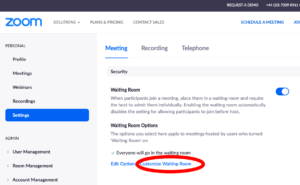
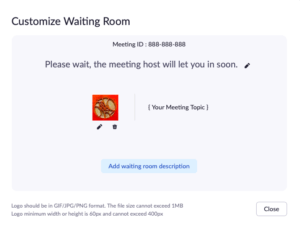
My preference for managing the waiting room is to wait until you are ready to admit people and then admit them all at once but you can obviously admit them one by one. It is then your choice whether you still want to monitor arrivals after the meeting has started or just untick ‘enable waiting room’. This option is under Security when in the live meeting. However if you don’t recognise people’s screen names there is the ability to send them a message to ask them to clarify who they are. If you click on ‘Participants’ you can view everyone in and out of the waiting room and message them and/or let them in individually etc. Attendees can rename themselves by clicking on the three dots showing on their image. Attendees can also ‘hide self view’. I do this when virtually meeting my family!
With regard to what you call yourself on Zoom I did have a problem once when I couldn’t identify the speaker in the waiting room. Her name was Caroline but her Zoom ID was ‘Carrie P’ with a picture of a cat! Right up to the time of the meeting I thought she hadn’t arrived and phoned her only to discover she had been there all along. So please ask your speakers to rename themselves on Zoom if need be.
Unless you are both the speaker and the host – which I wouldn’t advise – it’s a good idea to turn off the audible doorbell when people arrive as this can be distracting for others. This option is further down on the Settings menu.
![]()
Introductory slides at the start of the meeting
When you admit people to the meeting it’s good practice to have a slide already shared with the name of your organisation and the title of your talk. Without this the newly arrived attendee might wonder what is going on and whether they have missed something.
With Chingford Historical Society our chairman Gary always has a couple of slides on a loop whilst he gives an introduction to the society and welcomes people as they arrive. It looks professional and is a perfect opportunity to sell ourselves too! We normally start letting people in about 5 minutes before the start of the advertised talk.
Having attended quite a few online talks the experience of arriving into the meeting can vary wildly. Earlier this week I arrived to a cacophony of sounds of everyone talking over each other – see next point – whereas at a meeting yesterday I was greeted by silence. There was a discussion in the chat about playing appropriately themed music to welcome guests but then you would have to negotiate the copyright minefield!
At yesterday’s meeting they decided to wait a few minutes for latecomers. This is a pet hate of mine as it encourages people to be late on future occasions. With free to attend events both virtual and in real life there is sometimes a large number of no shows. At yesterday’s meeting 60% of those booked didn’t turn up! Waiting for latecomers is not fair on the people who have arrived on time. Thankfully on this occasion they only delayed by 3 minutes.
Here are a couple of introductory slides from Chingford Historical Society’s online meetings by way of examples. Both of these talks can be watched on our YouTube channel. You will notice that we have a template for our slides which also helps to give a professional appearance.

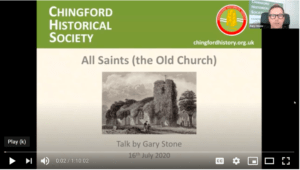
Mute participants on arrival and keep them muted
It is very important to mute participants upon entry. I attended a meeting earlier this week where everyone was unmuted including one person who was having a phone conversation with a friend about someone who had died. She was obviously unaware that her conversation was being broadcast to the 40 odd people in the meeting. Unless there is a very small group of people you can’t really have a chat like you do in real life and every comment you make ie to your cat or to your children will be broadcast!
The best way to deal with questions after a talk is to ask attendees to type them into the chat box. The host can then ask those who have asked the questions to individually unmute themselves to ask their question.
If you look at the list of participants those who are unmuted (intentionally or unintentionally) are always at the top of the list so can easily be found. Other participants are then in alphabetical order.
Turn off ability to annotate in advance of the meeting
Have you ever attended a Zoom where there are suddenly doodles all over the screen? This function can be turned off in Settings in advance of the meeting. It’s just under the Screen Share option.
Set up ability to assign co-hosts in advance
As referred to in Part 1 it is good practice to assign co-hosts to help with the housekeeping of the meeting ie to let people in and monitor people accidentally unmuting themselves.
The ability to assign co-hosts MUST be set up in advance of the start of the meeting. It is under Settings. Once you have clicked this to the on position it remains there for any future meetings.
Don’t put the Zoom link on social media
For security reasons it’s not wise to send out the Zoom link to all and sundry. I only send this bare Zoom link out to our CHS members who joined pre-May 2020 as they are mostly the ones that may struggle with this new technology. For everyone else they have to book a space via Eventbrite. CHS are offering free attendance for all until December 2020 but after that non-members will have to pay a £3 fee. Members will be given a code so they can book via Eventbrite for free.
Using Eventbrite means I can keep track of numbers. Automatic reminders are also sent and I have scheduled them to send 1 day before, 2 hours before and 10 minutes before the talk. You can adjust the content of the reminder and add the Zoom link too. One of the problems with Eventbrite has been that attendees need to be logged into their Eventbrite account (if they have one) to access the link embedded into the event. See how I get round this in the next point.
Zoom registration link or shareable link
Over the last few months Eventbrite have updated their offering for online meetings. However I have recently discovered that if you are hosting meetings via Zoom and click the Zoom option on the Eventbrite set-up this will then mean that attendees may have difficulty accessing the meeting unless they are signed in to Eventbrite. The Zoom link that is created in this way is not the link to join the meeting but rather the link to register. This means that the link isn’t shareable and you would need to ensure that everyone who is booked via Eventbrite is also registered on the relevant Zoom meeting.
You can avoid this anomaly by doing the following. When you arrive at the Online event page on Eventbrite – see image below – click ‘Livestream’ rather than ‘Connect Zoom’. There is an option to ‘Add Livestream instructions’ and this is where you can insert the Zoom shareable link that you have already created. You can then add the shareable link to your automatic reminders and send to the speaker or those less comfortable with technology. This is a bit difficult to explain so please let me know if you need clarification.
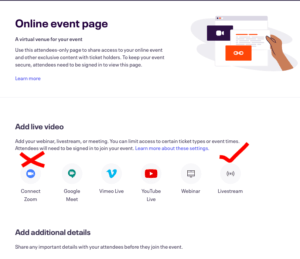
Zoom webinar or meeting?
Webinars – only the presenters and their shared screens are visible; you have no idea who else is attending. I have attended some very good webinars hosted by the Museum of Freemasonry. These are relatively short but have had fascinating content. Questions were taken via the chat function but were not visible to other attendees.
Meetings – are much more social as all the attendees are visible. That is if they keep their videos on. I have attended and spoken at a number of meetings where you are speaking to a row of screens with just the name showing. This is quite disconcerting for the speaker. As an attendee I am guilty of turning the video off whilst cooking my dinner or doing the washing up but I confess to doing the same if I have lost interest! So if you’re speaking to a load of turned-off videos you could get the impression that no-one is listening! Although attendees are visible during the presentation if the meeting is recorded they aren’t visible on the playback unless they make a noise or speak.
I have attended a number of meetings where the hosts have advised attendees to turn off their videos as it saves bandwidth. My belief is that this only helps if you are the person presenting ie if you have a dodgy internet connection turning your video off may help. If I am wrong with this assumption please let me know.
Advertising your talk
Lastly, here are a few ideas to get your talks to a wider audience.
Firstly – is your society a member of the British Association for Local History? If so see page 35 of this month’s Local History News for details of how you can get your virtual local history events onto their website.
The following are some websites that include submissions from individuals for free. However inclusion isn’t guaranteed.
UK-wide websites
https://www.ilovefreegle.org – you will need to create an account in the area your event is. Once you’ve done this you can add events to their Community Event section. So far I have only tried to add free events.
London only websites
https://www.timeout.com/london/get-listed
I hope some of the above tips are of use to you in getting your local history society online. It was a steep learning curve back in April but has certainly been worth the effort involved. I hope more local history and family history societies will attempt virtual meetings and from a personal point of view I could then attend talks on the areas my ancestors came from ie in Dundee, Manchester, Preston and Northampton.
Lastly I would be happy to help answer any queries you may have. Please either comment below or send me a message via my Contact page.
0 Comments